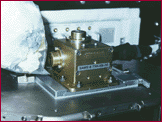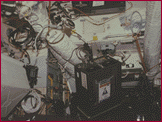




Objectives
The objectives of this experiment were: (1) to measure the microgravity acceleration environment on Mir in support of US and Russian Phase 1 investigations and (2) to characterize the microgravity environment and pass knowledge to Principal Investigators.
Shuttle-Mir Missions Approach Results
Mir microgravity acceleration levels generally similar to Shuttle. Different equipment give different characteristics. Major features: vehicle dockings, crew exercise, gyrodynes, Mir flight attitude, Mir susbystem equipment, crew daily cycle.
Publications Principal Investigators![]()
STS-76, NASA-2 - NASA-7, STS-91
SAMS consisted of three triaxial remote sensor heads of different frequencies (only two sensor heads were functional during the Mir missions) that were designed to (1) measure accelerations near science experiments during their operations (2) measure accelerations in support of Mir Structural Dynamics Experiment (MiSDE). The sensor heads were moved into different locations on the Mir to characterize accelerations at different vectors. SAMS was activated to support a variety of mission events such as Shuttle docking and undocking, Progress docking and undocking, Soyuz docking and undocking and crew activities. Acceleration data from these events and others were recorded on optical disks. The data were processed into spectrogram plots.
SAMS acquired over 50 gigabytes of data which represents 3,500 hours of operations.
None available at this time.
Richard Delombard
NASA/Lewis Research Center
![]()
|
|
Curator:
Julie Oliveaux
Responsible NASA Official: John Uri |
Page last updated: 07/16/1999
.gif)